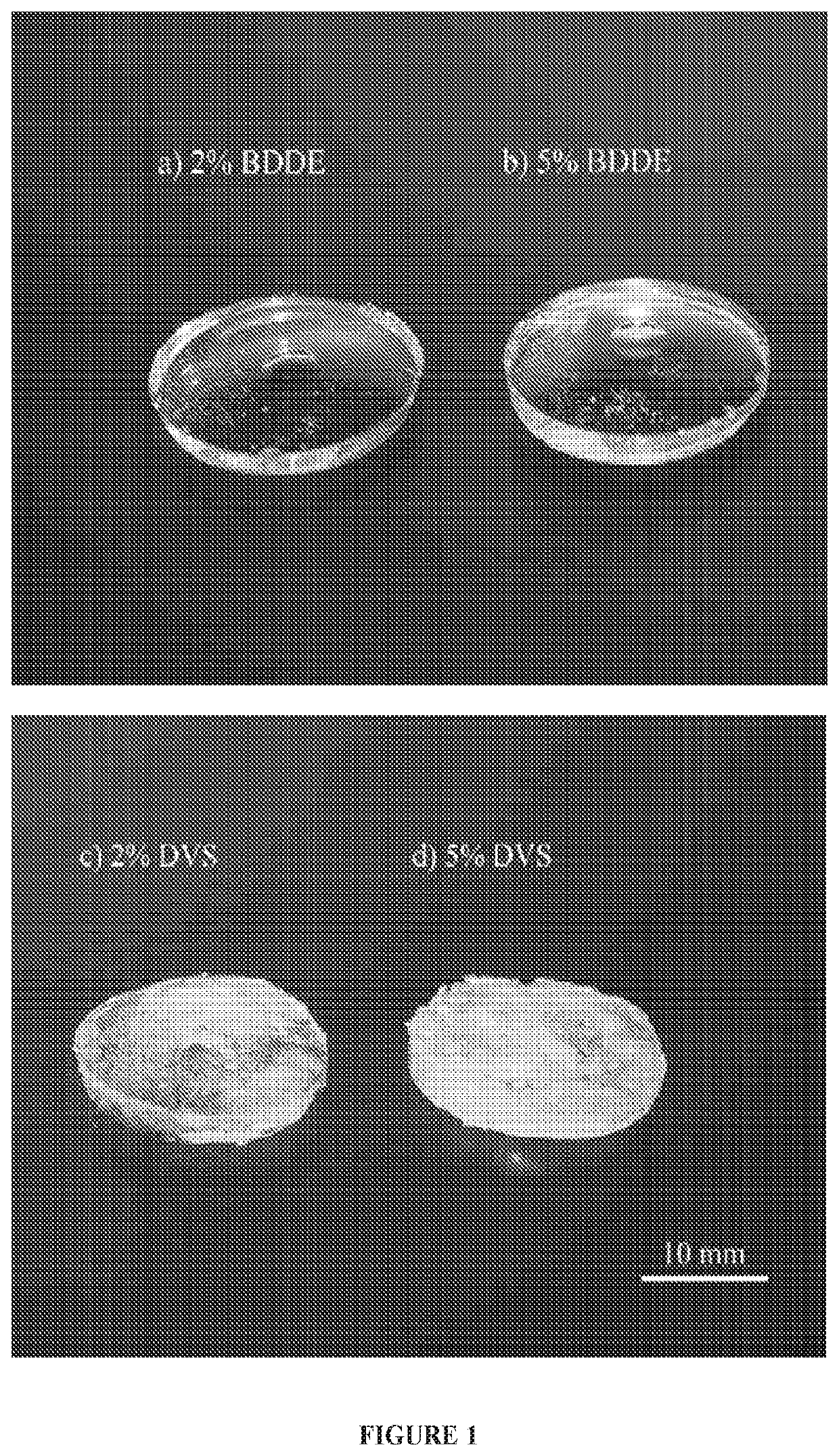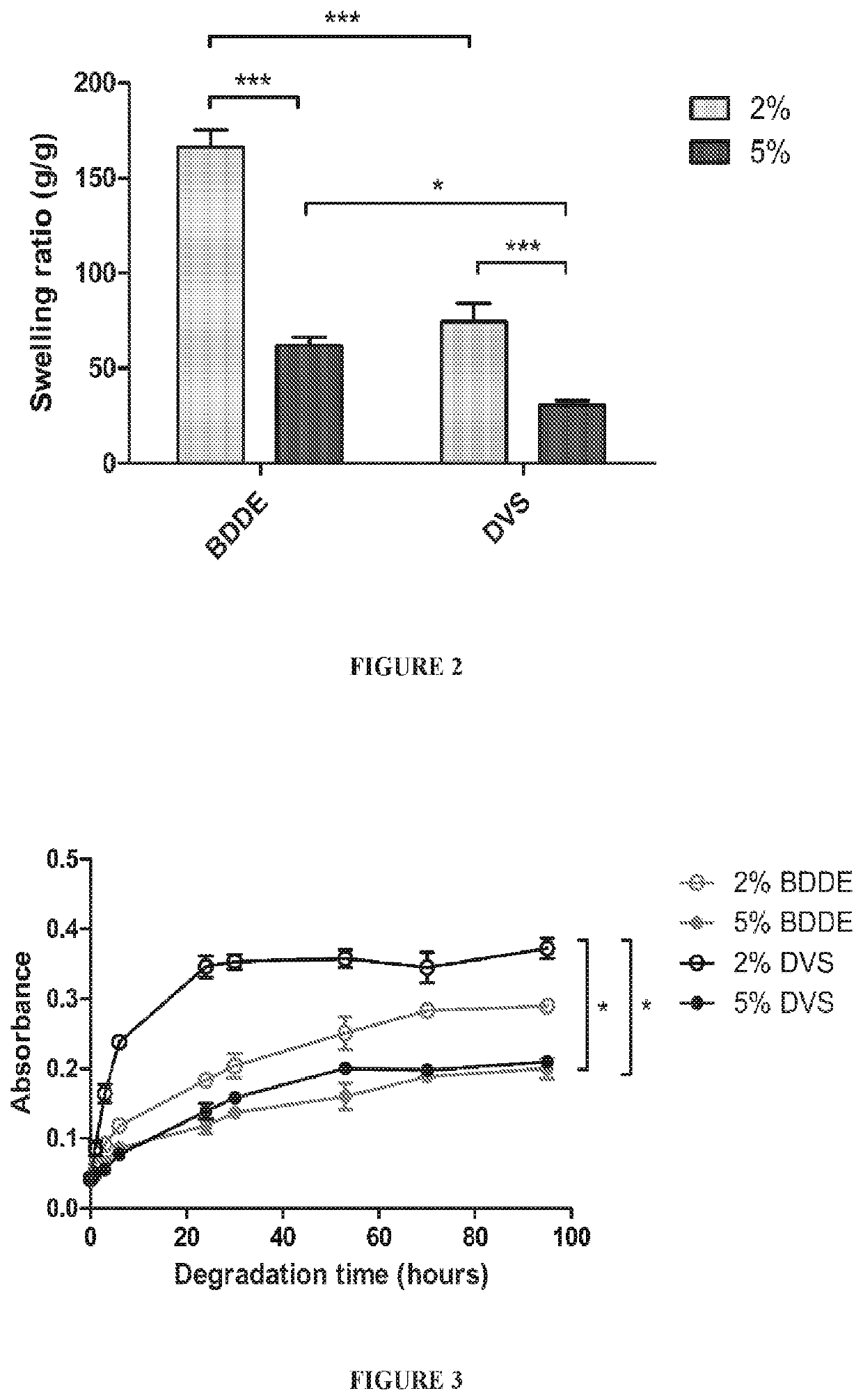Cross-linked hyaluronic acid hydrogels comprising proteins
a technology of hyaluronic acid hydrogels and proteins, which is applied in the direction of tissue regeneration, pharmaceutical delivery mechanisms, prosthesis, etc., can solve the problems of unrealistic one-step procedure, unfavorable treatment effect, and inability to meet the needs of certain applications
- Summary
- Abstract
- Description
- Claims
- Application Information
AI Technical Summary
Benefits of technology
Problems solved by technology
Method used
Image
Examples
examples
1. Materials and Methods
1.1. Hydrogel Preparation Methods
Method 1—Preparation of Crosslinked HA Hydrogels
[0242]Crosslinked HA hydrogels were prepared using 1.34 MDa freeze-dried sodium hyaluronate from bacterial source (Contipro, Dolní Dobrouč, Czech Republic), butanediol-diglycidyl ether (Sigma-Aldrich, St. Louis, Mo., USA), or divinyl sulfone (abcr, Karlsruhe, Germany) and NaOH to provide alkaline condition required for the crosslinking reaction. The crosslinkers (BDDE or DVS) were used in 2 V / V %, 5 V / V % and 10 V / V %. BDDE or DVS was mixed with 1 ml 1% NaOH (Molar Chemicals) and then added to 133 mg sodium hyaluronate and immediately vortexed until a homogenous gel was formed. The hydrogels were centrifuged at 1700 g for 3 minutes to get flat gels and allowed to crosslink for 48 hours at room temperature in a plastic vial. The crosslinked gels (FIG. 1,) were washed and swollen until equilibration with 80 ml distilled water in three steps, 12 hours each step. (In earlier procedur...
example 2
2.1. Swelling Ratio
[0258]Swelling ratio is the quotient of the swollen and the freeze-dried gels' weight. It is proportional with the degree of cross-linking; a strongly cross-linked hydrogel has a lower water uptake capacity and swells less than a weaker cross-linked gel. One-way analysis of variance (ANOVA) with Tukey post hoc test was performed and it was observed that the gels containing 2% cross-linker had significantly higher swelling ratio than 5% DVS or BDDE containing gels. In addition, the gels cross-linked with DVS were significantly less swollen than BDDE gels containing the same amount of cross-linker, consequently, their cross-linking density is higher (FIG. 2).
[0259]In vitro enzymatic degradation was examined with the help of Ehrlich's reagent, which determines the concentration of NAG (N-acetyl-glucosamine), the product of HA degradation (FIG. 3). HA gels were digested with hyaluronidase enzyme from bovine testis. NAG concentration, which is...
example 3
Treatment of Mice with Hydrogel
[0263]Homogenized gel suspension prepared according to Method 3, as described in Example 1, section 1.1. (FIG. 7,A) has been injected into mice as follows: 200 ul of homogenized gel was injected subcutaneously in both the left and right inguinal region of black six type 6 week old mice. The right injection site contained homogenized HA, which was crosslinked with fibrin, the left site contained only homogenized HA, (type SD, that stands for HA prepared using 5% DVS as crosslinker). The mice were sacrificed 12 weeks later, the consistency, vascularization and weight was investigated, it was found that generally the initial gel still contained crystalline type HA parts (FIG. 7.A), but the implants 12 weeks later were filled with connective tissue and vascularization already took place (FIG. 7.B). Surprisingly, the fibrin containing implants contained a larger vascularized ratio (FIGS. 8A and C, type SD “Fibrin”), compared to the gels, which did not conta...
PUM
| Property | Measurement | Unit |
|---|---|---|
| molecular weight | aaaaa | aaaaa |
| molecular weight | aaaaa | aaaaa |
| molecular weight | aaaaa | aaaaa |
Abstract
Description
Claims
Application Information
 Login to View More
Login to View More - R&D
- Intellectual Property
- Life Sciences
- Materials
- Tech Scout
- Unparalleled Data Quality
- Higher Quality Content
- 60% Fewer Hallucinations
Browse by: Latest US Patents, China's latest patents, Technical Efficacy Thesaurus, Application Domain, Technology Topic, Popular Technical Reports.
© 2025 PatSnap. All rights reserved.Legal|Privacy policy|Modern Slavery Act Transparency Statement|Sitemap|About US| Contact US: help@patsnap.com



